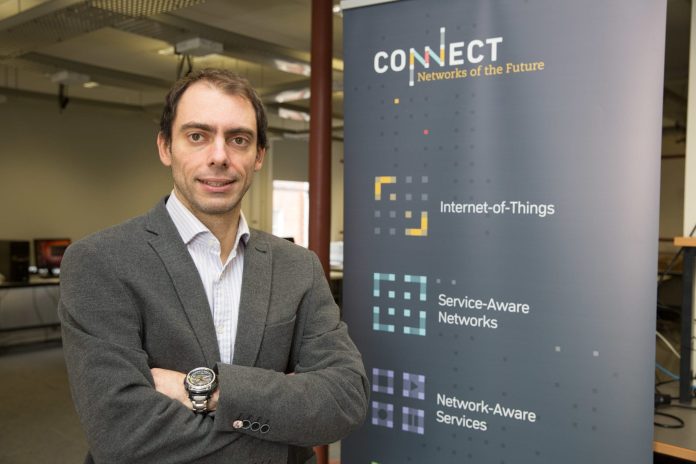A new €2 million open networking testbed has been unveiled in Ireland, for leading researchers in the field to collaborate with industry on 5G wireless radio, optical fibre, and data centre initiatives, and for Irish and European-led research into next-generation telecoms projects. The infrastructure will be used to research a variety of 5G and fibre techniques to hone a digital platform for broader industrial change.
The new Open Ireland project, run by CONNECT, the Science Foundation Ireland’s research centre for future networks, will be located at its laboratory at Trinity College Dublin, and extend to the Docklands area, where most of the capital’s smart city and explorative 5G networking initiatives have focused.
It will consist, initially, of a dedicated fibre connection between Trinity College Dublin and Dublin City University, as well as deployment of macro and small cells into the Docklands area. The project is funded by Science Foundation Ireland’s ‘research infrastructure programme’; additional contributions are expected from private enterprise.
It is led by Dr Marco Ruffini, associate professor in optical network architectures at Trinity College Dublin. Ruffini said: “This is a game-changer for networks research in Ireland: it will allow us to explore real-world situations outside the traditional laboratory environment, and it will open up the full span of the communications network – wireless radio, optical fibre, and data centres – for testing.
“Advances in communications networks will drive the digital economy. It is essential Ireland is a leader in the field… to experience benefits in fields such as telemedicine. Our approach is based on open networking solutions, which allow for the continuous improvement of the network. This has the potential to deliver… intelligence based on machine learning algorithms.”
Ruffini said the Open Ireland project will facilitate collaboration between academia, industry, and local authorities – as prescribed by local government in a recent discussion document – at a “practical, project-based level”. Enterprises from different sectors, and from different disciplines within the tech market, will be invited to share costs on joint research that leverages the new infrastructure.
Ruffini said this extends to all manner of agencies and organisations in the smart cities and Industry 4.0 sectors, as well as to mobile operators themselves. The project will utilise the infrastructure as a springboard to test sundry networking pyrotechnics.
Ruffini listed these: “Access network virtualisation, AI-based network control for wireless and optical systems, mesh networks for edge cloud and cloud-RAN, telemetry for monitoring quality of service and service level agreements, use of distributed ledger technology to implement smart contracts. These are just a few.”
He explained: “The testbed has the potential to target elements of both smart cities and Industry 4.0. Initially the scale will be around the docklands area and in our laboratory. This can be extended through additional locations, as interests arise from industry.”
The Open Ireland project may be used, also, to explore different LTE and 5G sharing models, including neutral host setups. It might be noted, the initiative is separate (”complementary, perhaps,” said Ruffini) to the Dense Air neutral host small cell project in the city’s docklands area, designed to hasten network densification for in-building, IoT, and backhaul connectivity.
Collaboration with the operator community in Ireland could, feasibly, focus on intra-public/private networking for industry as well, he suggested, where open LTE / 5G infrastructure dovetails with localised ‘campus’-style networking using operator-owned frequencies.
Ruffini commented: “Operators, like all industry, can engage through cost-shared targeted projects. They can even bring their own frequency licence, so operations can be carried out within their allocated band. This can be localised, for example, to the dockland area. In this, our infrastructure could be used to carry out confined experiments, or else blend with the operator’s network.”
The other major aspect of the research work, he explained, will be around beyond-5G (6G) wireless networking, funded by Science Foundation Ireland or the European Commission. “Here, we are likely to focus more on longer-term goals, including new technology that go beyond the current 5G offerings.”
Professor Linda Doyle, dean of research at Trinity College Dublin, commented: “For the first time, researchers will be able to perform end-to-end research across heterogeneous network domains. This will be a significant support for applications for major European funding awards, and will enhance the national research ecosystem.”
Dr Siobhan Roche, director at Science Foundation Ireland, said: “This new research infrastructure will accelerate Ireland’s development as a global leader for innovation in next-generation communication networks. It will be a significant asset for attracting research funding and industry investment in Ireland.”
In January, the Irish government unveiled a five-year Industry 4.0 strategy to help manufacturing firms to respond to technological change. The plan includes €23.5 million of funding for the Irish Manufacturing Research (IMR) Centre, a joint initiative between Enterprise Ireland and the IDA, the government departments responsible, respectively, for economic development and inward investment in the country.
The government said the strategy is geared towards the development of new digital skills and technologies in the country’s manufacturing sector, and to drive collaboration between small, medium and large sized enterprises.

